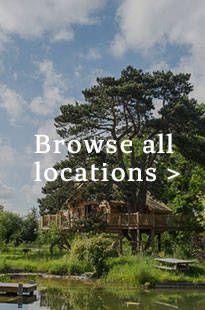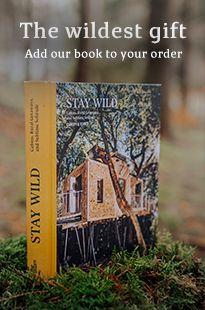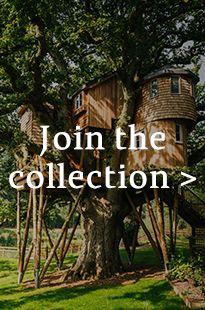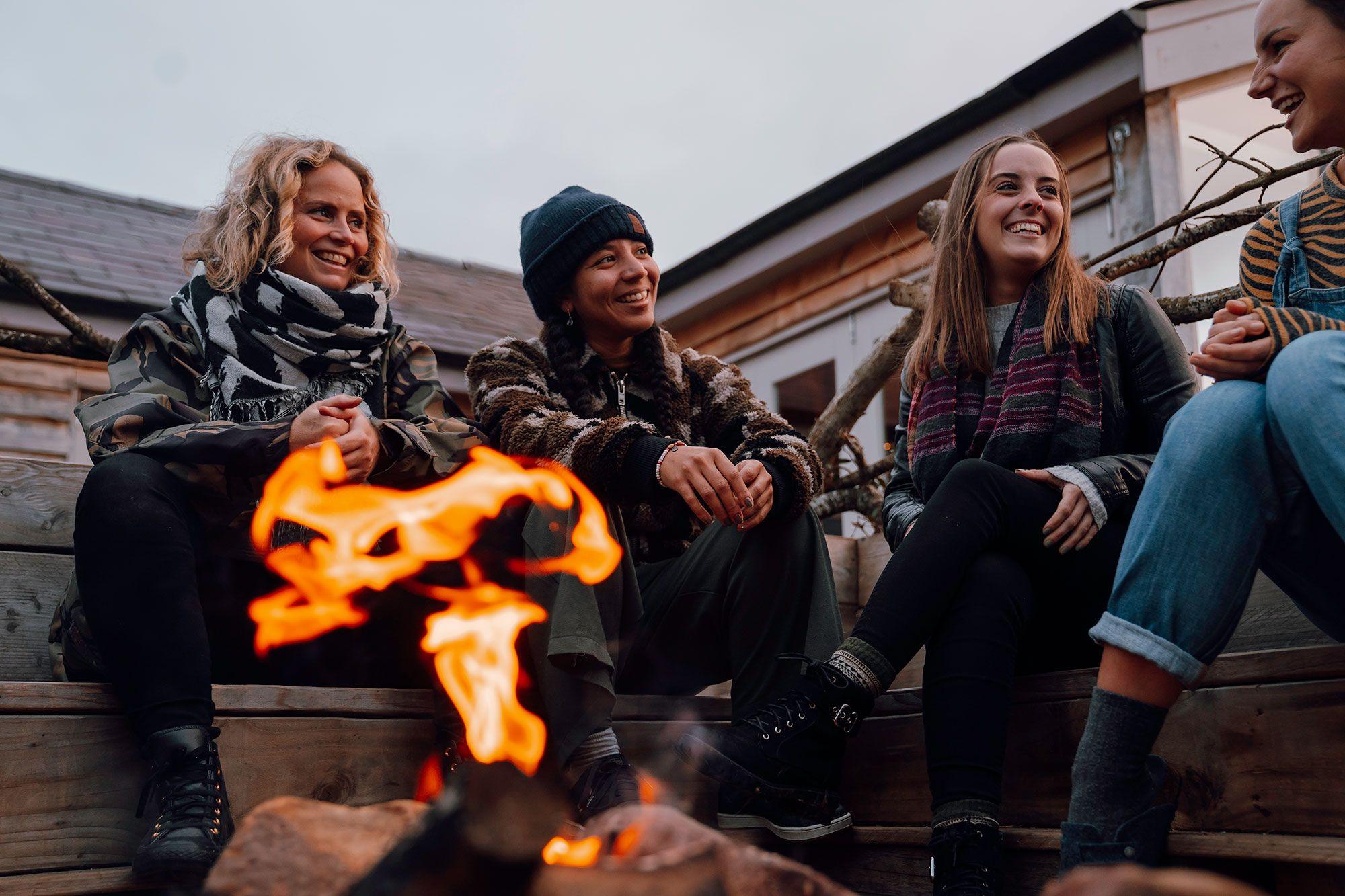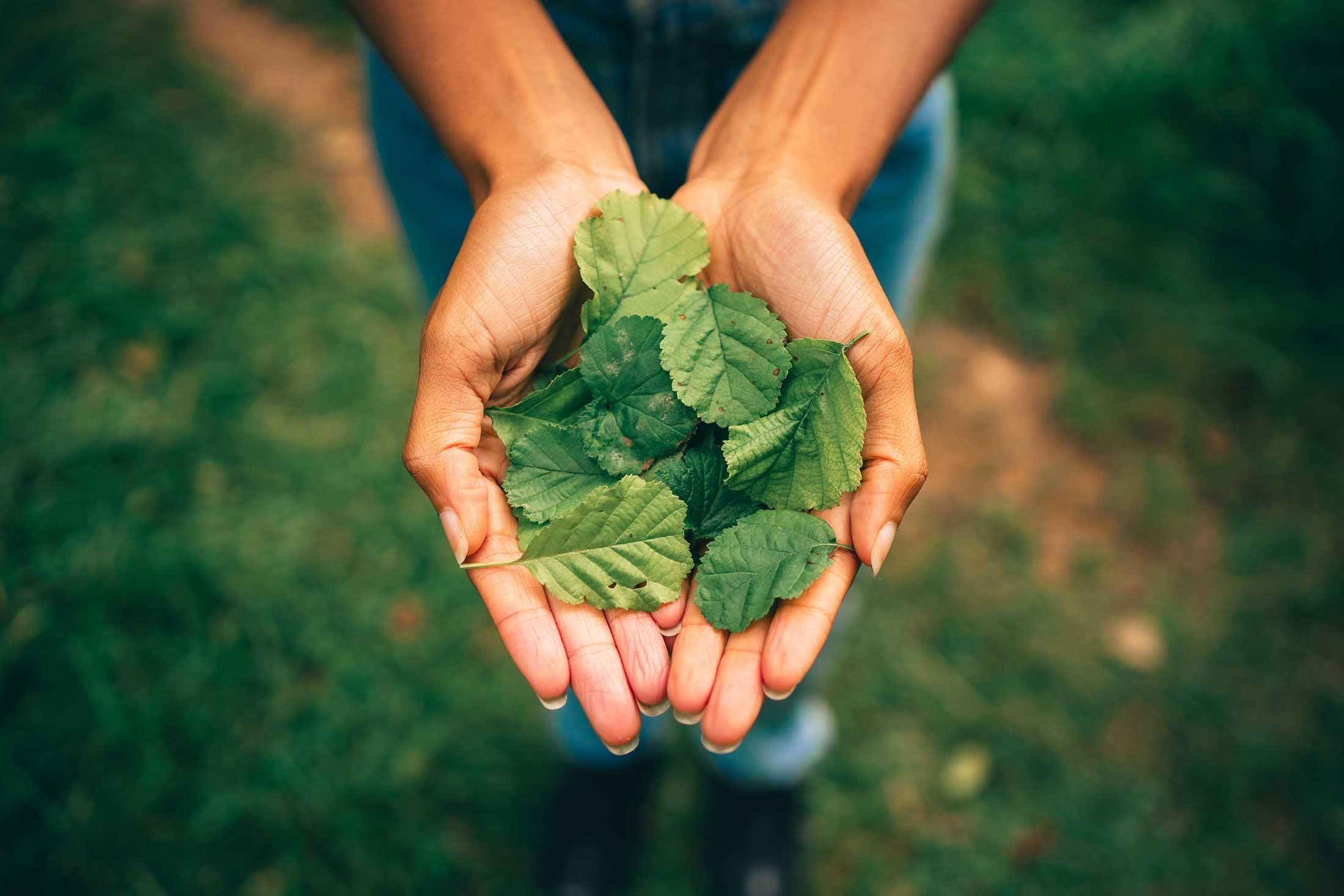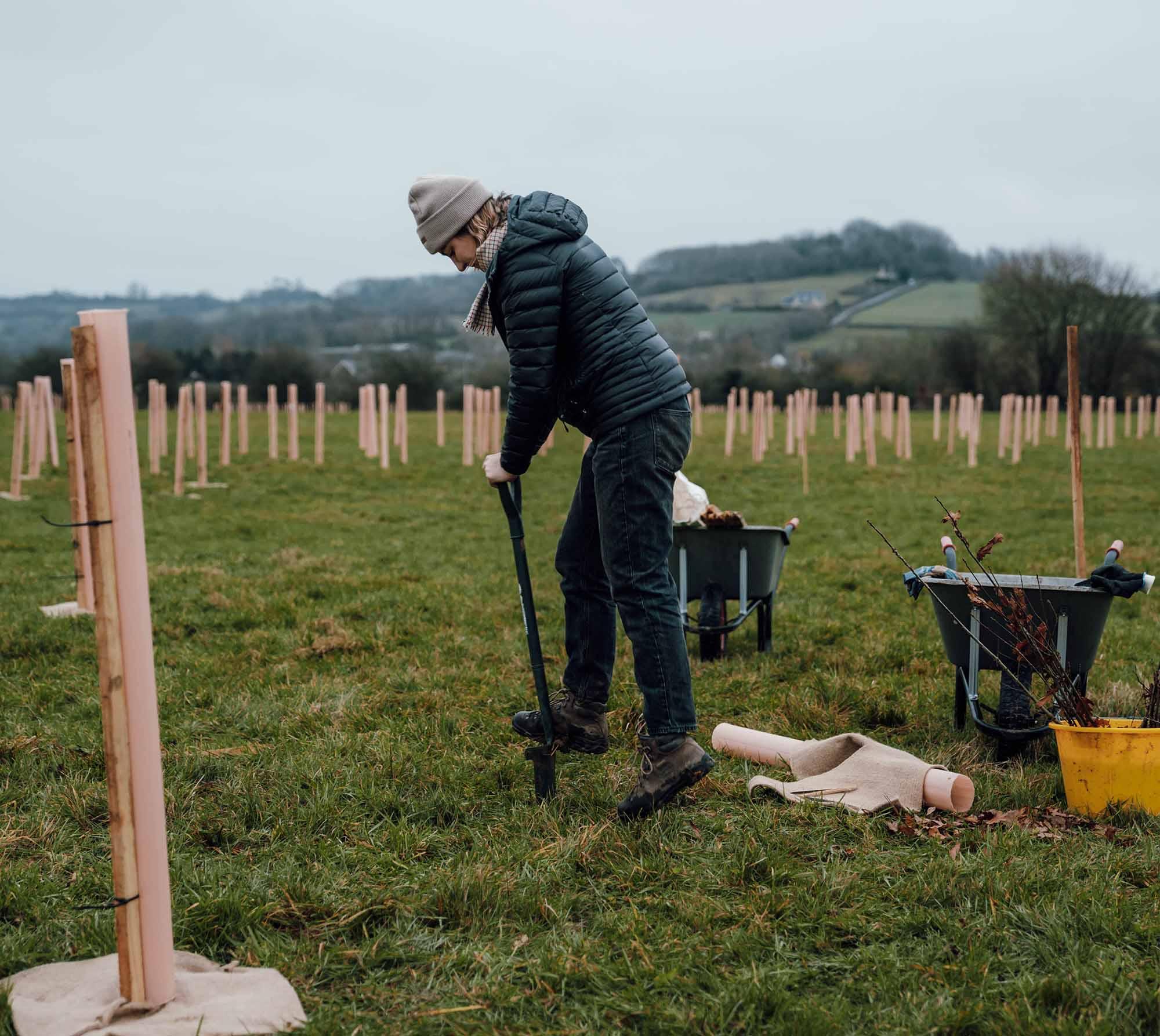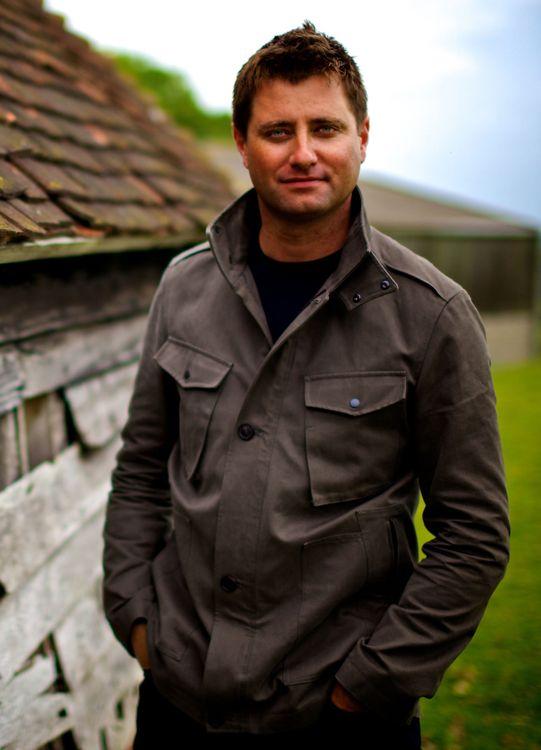
A Life More Wild - Series 2 Episode 9
George Clarke
Utopian Towns and Secret Projects – George Clarke
Our final episode of A Life More wild sees us chatting to George Clarke about his humble beginnings creating treehouses as a kid, and the journey it took to building some of his more famous creations. Our very own Siri Thomas gets George chatting about nature in the city, inspiration for his recent work, and even, a little teaser for what's to come...
Hi, this is Chris from Canopy & Stars and to finish off series two of A Life More Wild. We're bringing you a special bonus episode in which we chat nature and design with architect and presenter George Clarke.
I always say that Mother Nature's the greatest architect the world's ever had, he or she designs these, these trees and these structures that are wonderful ecosystems. She's the greatest architect ever.
George, it seems is always on the move. But our very own Siri Thomas managed to get him to sit still long enough for a call. Here she is talking to him about growing up in a new town, harmony between the built and natural worlds and creating his very own folding roof treehouse.
I suppose where I want to start with this is, your childhood and growing up, up north, and what influences that had on your career and your life in design and architecture?
Well, I was brought up in a new town. It was a brand-new town. It was developed in the well, all through the 1960s. And in lot of ways were still being built when I was growing up and then in the early, mid to late 70s. So, in effect, I was brought up on a brand new utopian development. It was like one big architectural experiment to house 60,000 people as quickly as possible, and a new town. It's a town called Washington. It's between Sunderland and Newcastle. It's where George Washington's ancestors were born, you know, the first American president. So, we have all these American tourists turning up every year, to this little new town up in the Northeast. But actually, because the landscaping was so brilliant, the way that our houses were positioned with, amongst trees and bushes, and plants, and everything else it was, we used to build dens like all the time, we would go and build camps, out in the woods and in the trees. And we loved it, I mean, that's I would say that was some of the first small space structures that I ever, I wouldn't even say designed. We just made it up as we went along. Because it depends on what we could build out off. But yeah, half designed and definitely built. It was years later when I was doing my architectural training and I thought hang on a minute. This is like a collection of great designers, planners, highways, people, landscape designers all coming together to create this utopian New Town. When I look back, that definitely inspired me to become an architect really.
And were there other elements in your life, I suppose, outside of the home and the house that you grew up, people that influenced your, I suppose obsession with, with, buildings and creating?
Obviously, my granddad was an inspiration. My grandfather was a builder. He was brilliant. I mean, he really inspired me to, to, get involved in construction. He used to tell me to kind of keep my head up and look up at buildings and look around me, 'don't have your head down'. And that just made me see buildings. I mean, when I say see, I mean really see, like really look at them, and really start to understand them. My dad was a kind of, amateur cartoonist and animator. He used to do lots of drawings and sketches. I used to get bits of tracing paper and put them over like the Charlie Brown cartoons in the newspaper and trace over them. So, as a kid my dad told me to draw my granddad told me to build and then my friends and me taught each other how to build, funny little dens, and weird little bizarre tree houses in woods around the house.
Sounds like you're doing amazing spaces far beyond the TV show.
Like in 1982 or something like that. We were doing it but yeah, they, they weren't that good.
What impact did the outdoors and nature have on you? As a young boy, despite growing up in what sounds like quite an urban setting, in a new town.
We were always playing outside. We were always amongst nature, okay, it wasn't wild because we were in a town, but we were surrounded by nature and greenery all the time. It was brilliant. But then you know, as I, as I kind of got a little bit older, my, my uncle took me walking, my Uncle Johnny took me walking, and when I was kind of 15/16 years old. He took me to the Lake District for the first time. That kind of changed my life to be honest with you. I mean, um, if anyone said to me now, 'what's your kind of favourite greenest place on earth?' I would say the Lake District. I fell in love with it completely at 15/16 years old. I was kind of reading The Hobbit and Lord of the Rings at the time when you know, there was just It just felt all kind of Tolkien-esque being in the lakes. Then I would start to read more literature related to the Lake District you know, Byron, Wordsworth you know, all the, all those wonderful romantics basically from, from the 18th century were just kind of a big inspiration on me really, even to the point where my first big, proper design thesis at university was a project at the lakes you know, I was kind of, my caravans there. You know. I'm doing a new caravan which we can talk about a bit later, but I'm an obsessive walker. I mean, I'm, I've kind of climbed mountains and done trails and treks, as I say, since I was 15 years old and under the grand age of, 48, you know, big walks, you know, I'll do 25 miles a day if I need to, if I can, you know. We did, me and a good friend of mine, go up to Hadrian's Wall, we've got the lakes, we've got the Northumberland, we've done St. Cuthberts Way, we've done the Northumbrian coastal walk, and you name it, we've done, I've done so many walks, I've been up to the Brecon Beacons, I'll just walk for, for, 10/12/13 hours a day, get 20/25 miles under my belt, fall into the bed and breakfast and go the next day or wherever I can sleep.
So, what is it about walking?
Do you know what, it's many things. I'll do it on my own. If I need to, for me, it's getting away. You know, you can imagine in my job, it's very busy. And yeah, I love it. And I love meeting lots of people. And I love to learn about design and architecture but I love being on my own sometimes. It's nice to just get away. I love the exercise. I love the fresh air. For me, it's good for my mental health and wellbeing you know, it's blows away the cobwebs, I walk all year as well. You know, I mean, I actually love walking in the winter. Some people think I'm nuts, but I love it. Because it's really, really quiet. And you feel like you're being battered by the elements. I'm from Sunderland for God's sake. I mean, you know, you get battered by the winds of the North Sea a lot of wind and rain. So, it's exercise, clears my head. I even love map reading, you know, I just love maps, I don't use my phone when I go walk and I turn my phone off for 10 hours.
It's quite rare.
I'll turn my phone off quite regularly and that really annoys people and I just enjoy that even more. It's good to just switch off from it all. And be outside and that fresh air and I love Britain. I love it. I mean, you know, I'm, I'm a proper Brit. I love it. I think we've got the most beautiful, beautiful country, I think we're so lucky to actually be on a relatively small island with such a diverse landscape. Look at the Lake District. It's bonkers. It's nuts. It's like it's actually a very, very tiny, condensed area, you can drive from one end of the lakes to the other in an hour. And you're going through some of the most dramatic landscape in Britain. If you want more of that and more expansive landscape go to Scotland. Off the scale beautiful. I absolutely adore Scotland. I don't even want to talk about Northumberland too much, because I love it so much. I don't want anybody to go. Because it's so nice and quiet. I think Northumberland is one of the best kept secrets in Britain, if I'm really honest with you, because lots of people from the South will go to Scotland and go to the lakes. And you know, they might take a slightly easier drive and go to Wales, or they'll go to Cornwall, and they just forget about Northumberland and it's absolutely magical. And I'm obsessed by history. You know, I'm gonna go on about all this stuff. I'm obsessed about Britain for hours and hours and hours. And you haven't got enough time in this podcast. But yeah, I adore history. I love it. I loved it at school. I think if I wasn't an architect, I would have either become a photographer or, or a historian, I think. And that's what's nice about my job, because without architecture, I can take photographs, and I can get absorbed in quite incredible architectural social history. So, I've got the best career in the world for my interests, because it covers everything really.
And how much has your design work and build work been influenced then by the geography of Britain?
I think one of the one of the sad things I think about a globalised world now is that, a lot of architecture is starting to look the same. Just look at some of the contemporary modern houses that are built all over the world. They tend to look like super modern boxes, you know the sort of boxes, you would have seen in LA in the 1950s and 60s, you now see in parts of Cornwall and Scotland and all over the place and, and a lot of it looks the same. And I think that's kind of a sad side of globalised architecture really, if I'm honest with you. For me, historic architecture is about local materials, you know, respondence to the local landscape, respondence to the local climate, you're designing for those unique counties that we have. Not, I'm not talking about massive regions here I'm talking about counties you would see variation between one county and the next you just have to look at a kind of geological map of Britain and see the variation of quarries and the seams and strands between limestones and sandstones and granite and marbles and clay and brick, and you know different timbers. You know, that you'll that you'll find across the country as well. And that that generated what we know as vernacular architecture which was basically responding to everything local, everything close to hand. A house in Scotland absolutely should look different to a house in Cornwall and a house in the lakes or house in Sunderland or a house in London or a house in Kent. When you've got very good planners and very good architects who understand local design and local materials, it's I find that really exciting you know?
Do you have one project that you've been involved in, that stands out because of its connection to the surroundings?
Well, I'm going to plug a new one. I'm going to give you a tiny little nugget, a little tease.
Go on...
So, Canopy & Stars started in 2010. And it was around that time that I was given some books by a woman called Jane Field, and Jane Field wrote a series of coffee table books called 'My cool...'. It was My cool caravan, My cool campervan, My cool treehouse. So, around the time of Canopy & Stars starting in 2010, Jane had published these books around that time as well, about small spaces and wonderful, unique tiny pieces of architecture. That then led on to us thinking about is there a series in this and Channel Four? Were like, let's do it. It was just amazing with Canopy & Stars and Jane writing these books and me seeing some small spaces being created. We were kind of, hang on a minute, there's a there's a kind of movement here. In quite unusual, inventive, innovative, small space architecture. And it's our 10th anniversary of amazing spaces this year. So, the idea for it, when the programme was commissioned, we were just going to feature other people's builds. And I said, 'Look, why don't I do one? Why don't I do a main build? Each series, and we string it across all episodes? Why don't I take a 1970s caravan, which would have been the type I would have stayed in as a kid. And why don't we do something amazing with it. Even though it was probably one of the quirkiest, bizarre, probably one of the cheapest projects I've ever taken on my life. It's still one, that I'm massively proud of. And my kids absolutely loved it. You know, they preferred staying in that caravan than any fancy hotel I might take them to and to kids love fun architecture. So, 10 years on, this is my little exclusive for you. I'm doing a new caravan -- to replace the old one. It's just tired. It's been in the Lake District for 10 years been absolutely battered by the Cumbrian weather. So, I've set myself a challenge on the 10th anniversary series, is to replace the caravan. It needs to appeal to me and my family in a different way, because my daughter was four years old when she was in the first caravan and now, she's 14. Emilio, my older son's 17. And my eldest son, George is 19. So, it's now a kind of caravan for young adults and older adults, like me. But also, I want it to be low carbon. It's on a National Trust site. They have a new kind of low carbon, zero carbon agenda. And so, I said, 'Well, come on, you know, if we're going to do this, let's design the most brilliant, very low carbon, long lasting, highly insulated, structurally strong, wonderful piece of landscape architecture' If you like, if it's like the caravan can be that -- something that really genuinely enhances the landscape. If we're going to be very serious about the zero carbon or low carbon agenda, then you know what better place to start than the humble caravan.
I'm obviously familiar with one of your very popular spaces Sky Den, and Northumberland that has an extremely unique connection to nature with its peel back roof, and on the river. What about those elements?
The architectural concept for, for Sky Den was staggeringly simple. Take a square, take a circle and take a triangle, three very simple elements of architecture and make it into a treehouse. The square is, is, obviously a cube of habitable space, with a kitchen in there and a living area and dining area. The circle is a tube which is an outdoor camping area, you know, a kind of outdoor den that you can kind of sleep in and cook in and be sheltered from the elements but feel very connected to the outdoors because it's not wind and watertight. And then the triangle on top of the bedroom, and the roof opens. Northumberland has dark sky status there's nothing better than being there looking at a clear starry night and looking up at the all the constellations and it's, to have that space open, to get that triangle to open up and, and be able to lie there and look at the night sky is a very, very magical experience. So yeah, we're really proud of that one. You know, it's it wasn't easy. It was unbelievably hard. We were building into the, the side of a riverbed, we had to make sure it had strong footing structure. Structurally, it's probably one of the most complicated projects we've ever done, to be honest, so it might look effortlessly simple. But the engineering behind it was, was really quite complicated. But yeah, one that we were very, very proud of.
And you've seen hundreds of amazing spaces, is there anything you've yet to see, or that is on your list that you want to see?
Do you know what, I think I want to go to some more remote spots in Scotland, I see all these kind of wonderful little bothies, I've seen a few actually, that you have to walk to, and you can't really get vehicle access to, I love the idea of that. I love the idea of literally just have my backpack and my camera. You know, the simplest of supplies really, do a bit of fishing, catch a fish, cook a fish, and just hide away at a little bothy somewhere, on a Scottish coast. I'd love that. Take a book, no mobile phone, no conversations. And yeah, just hide away up, up in Scotland. I just like things being very, very simple. I really, genuinely do. I don't need many luxuries in life. As long as I've got my nice camera, and I've got a nice book. That's kind of enough for me really, genuinely, I really kind of mean that to be honest. It's fantastic. And I mean, I make out that I'm this, complete loner. I mean a lot of walking I do; I do with a good friend of mine called Mark. And we just kind of talk and talk and talk and put the world to rights when we walk for hours and hours. And that's, that's great fun as well. I never walk with more than one other person though. Isn't that really antisocial?
No, I don't think so.
Just all gets too busy. All the conversations get too complicated. And then people start having debates because there's more than two opinions. So, I'll just keep it very simple, me, my mate Mark. That's it. So, it's really good fun.
You mentioned earlier of your obsession with Britain. But are there any countries that you think are leading the way of involving nature in their design?
New Zealand's love it? Absolutely love it, you know, there's only four and a half million people on the landmass, kind of the same as ours, a little bit longer, a little bit skinnier. You know, we've got nearly 70 million people have a similar area of land. So, you feel very remote when you go over there. You cannot help but be, directly connected to mother nature when you're there. I think Denmark, Finland, Sweden, Norway, every time I go through Scandinavia and go back to Denmark, and places like that, it's I feel really connected to the place, I think we've got a wonderful connection with nature. And then Japan, I would say Japan, you know, Japan is, one of the most nuts places on the planet that you know, you've got to Tokyo and you feel like you're in Bladerunner. You can actually go into a house in the middle of Tokyo. And it's been so beautifully designed where they've brought nature into those spaces that you do feel like, you're amongst Mother Nature, even in an urban environment. I think the Japanese are probably better than anybody else at creating pieces of urban architecture, as well as rural architecture, very much inspired by nature, and inspired by landscape. And then obviously, when you get out of those urban areas phwoar, I mean, they're amazing. I would say they're my kind of top five or six countries, Japan, New Zealand, Denmark, Finland, Sweden, Norway, Britain,
And you mentioned there about in Japan, incorporating nature in urban spaces, if you finding that demand for people in urban areas, is getting higher, asking for nature to be brought into the urban space?
Well, it should be though, I've been banging on about this for like 30 years, saying why is there such an abrupt divide between the built environment and the natural environment? You know, why do we have like, you can build here, there's a boundary line, and then there's the Greenbelt. You know, and obviously, we did that to protect the Green Belt. And that's a that's a brilliant, brilliant thing. But it's too extreme. You know, we go from literally kind of concrete, brick towns and cities to, wonderful nature, and you kind of think, come on, we should be living amongst nature all the time. Doesn't matter whether you're in a skyscraper, mid-rise building, low-rise building, why can't it be staggeringly green. Why can't Mother Nature take over those buildings? Really, I think one of the challenges for, for all architects and planners and designers and governments and everybody else, highway designers, everybody, is to, is to make our built environments, in harmony with nature. Why should we have to get in the car and drive for hours and hours and hours to find green spaces, when you should have it in your house? I mean, I've got indoor plants and I'm talking to you now, I've got indoor plants all over the place. My garden is staggeringly green. You know, my house is very green. I love it. In some ways my house feels like a kind of Japanese house. In some ways. I've got a kind of, courtyard at the front, which has got Japanese trees and plants there at the front, I've got another courtyard at the back, I love courtyards. Courtyards are just wonderful, protected spaces. And they can have that in an urban environment, or a rural environment. For me, it's about harmony.
Have you got any exciting adventures planned, something really special something with a really deep connection to nature?
I mean, I will, I will honestly say that in the 10th anniversary series that I'm making at the minute, which I'll finish in, the end of October, beginning of November, I'll be broadcast in the new year. There is definitely a green agenda on quite a lot of the amazing spaces projects. I would say more so than ever. I definitely think there's been a shift in people changing their lifestyle in the post COVID world, probably seen more campervan conversions in the last 18 months, than I've seen in the last five years. Where people have gone 'you know what, I just don't want to live in a, in a house in one place with a massive mortgage'. I've just filmed a lovely couple last week who have just done a houseboat. Never, ever did they ever imagine they're going to do a houseboat. Never had any inclination whatsoever, to do a houseboat. But when from going, 'we don't want to be in rental accommodation anymore'. Because it's expensive. And they weren't able to save up and get a deposit for a permanent house for themselves. They then looked at getting a piece of land and trying to build a small space project as a permanent home for them to be able to live on, land was too expensive. They just couldn't afford to do it, then they struggle to get planning even on some of the bits of land they could afford. And then they were like, well hang on a minute, what else should we do? And it was by default, without any plan whatsoever. They just went, what about a narrow boat. And they've said, 'we don't think we can ever go back to living in a standard static conventional home'. And I love that. Now, some of the listeners to this podcast would go oh, well, you know, they're not on the property ladder, they're not gonna have a property that's gonna go up in value by five 10% a year, they're living on a boat, which is going to go down in value, that entire project cost them just over 20,000 pounds. Show me a house that you can take wherever you want beyond the waterways, and live a wonderful, adventurous life and move it to wherever your job might be, because they had quite transient jobs where they might have to move to different locations. Show me that for 20 odd grand. Can't. It's got to be a narrow boat; it's got to be a boat. So, I think you're gonna see lots of projects, which are green, sustainable, life changing, genuinely affordable, but also create a very exciting new way of life, where you're not really burdened by huge amounts of debt for the next 25 years with a conventional house, and a conventional mortgage. And I find that really, really exciting.
I have one last question, George, which is like us, you also have a love for good tree house. What is it about your fascination with tree houses?
Well, I mean, treehouses go back thousands, if not millions of years. One of the reasons why treehouses were first built, well there was a number of reasons. Actually, one. One was, you know, back in prehistoric times, you didn't want to get eaten by anything. So, building a tree house kept you away from the ground, we could get attacked by animals. Luckily, we don't really have that problem too much anymore. Or by flooding, flooding was a big, big problem. So, living up in a tree gives you a lot of protection. What better place to live than in a tree? Crikey. I mean, trees, kind of one of the most wonderful pieces of structural ecological designs on the planet. I always say that Mother Nature's the greatest architect the world's ever had, you know, she designs these, these trees and these structures that are wonderful ecosystems that are structurally amazing. I mean, come on and have this like trunk, this skinny little trunk or going with these branches, gone metres and metres or metres it's a piece of cantilever structure. I mean, she's the greatest architect ever. And just being in a treehouse, even if you're not directly connected to the tree, and if you're just amongst the trees, you know, it's a wonderful place to be just elevated from the ground, clean, fresh air surrounded by greenery, lovely views, hopefully, if it's in a nice position. I don't think there's anything more romantic than a treehouse. And to design a good tree house. Is tough. To design a structure that is somehow going to be part of a tree or within a tree, and design it in a way that's very sensitive, doesn't dominate too much, you know, respects Mother Nature, and also creates a very unique experience using the right materials in the right way. In a very sensitive way. It's not an easy thing to do really. I get letters and emails all the time from parents saying, you know, Amazing Spaces is the only series we allow our kids very young kids stay up for, on a school night after eight o'clock. You know, I'm normally I'm on from eight o'clock to nine o'clock and parents let their kids stay up. Why? Because it's just really fun. It puts a smile on your face, it's escapist, it's, kids, look at some of the projects and go come on, come on mom and dad, or mom and mom or dad and dad and say, Come on, let's, let's, let's build something. Let's do it. Let's, let's do a studio at the end of the garden. Let's do a little treehouse. That's a campervan. That's, it's a series that I just really, really love to make. I'd be happy making it for another 10 years, because it inspires people of all ages, and lots of different ways. And most of our stuff is very accessible, very affordable, even if you've got 1000 quid or 500 quid. If you're willing to get a bit hands on and get help from family and friends, you can create your own amazing space even down the end of your own garden. And that's what makes Amazing Spaces really special.
George, thanks so much for talking to us.
Pleasure, I loved it. Really, really loved it.
And that's it from series two of A Life More Wild. So, I'll leave you sketching your dream treehouse. And we'll see you outside again next year.

